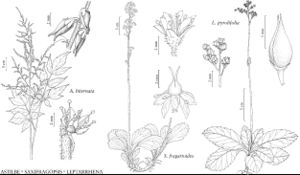Astilbe
Prodr. Fl. Nepal., 210. 1825 ,.
Herbs, clump-forming, not rhizomatous, not stoloniferous; caudex stout. Flowering-stems erect, leafy, 150–200 cm, stipitate-glandular with unicellular and multicellular hairs. Leaves basal and cauline, usually ternately decompound or 3-pinnately compound, never simple, leaflets short-petiolulate; stipules present; petiole present, glandular-stipitate, hairs uniseriate and multiseriate; leaflet blades ovate, largest terminal leaflet usually 3-lobed, base of leaflet oblique, truncate, or cordate, margins coarsely and irregularly double-serrate, teeth mucronate, apex acuminate, surfaces short-stipitate-glandular on veins abaxially, glabrous adaxially; venation of terminal leaflet pinnately-palmately netted. Inflorescences relatively large, plumose panicles, rarely congested and spikelike, terminal from terminal bud of caudex, (branched), 500–2000-flowered, bracteate, (elongate-triangular); (branches stipitate-glandular). Flowers usually unisexual, rarely bisexual, plants usually dioecious, rarely polygamous, (becoming reflexed in fruit, short-pedicellate); hypanthium 1/4 adnate to ovary proximally, free from ovary 1 mm, (shallow), greenish whitish; sepals 5, white [pink or red to purplish]; petals absent or (1–) 5, white [pink or red to purplish]; staminate flowers: stamens 8–10, (erect), inserted below rim of hypanthium, filaments filiform, (anthers cordate-orbiculate), ovary abortive, surrounded by distinct nectary disc; pistillate flowers: stamens abortive, pistils 2 (–3) -carpellate, carpels connate proximally, ovary superior, barely adnate proximally to hypanthium, 2-locular or 3-locular, with poorly differentiated nectary disc, placentation axile, styles 2 (–3), stigmas 2 (–3), capitate. Capsules 2 (–3) -beaked. Seeds brown, winged due to presence of loose seed-coat, often twisted at both ends, oblong-cylindric, striate or lightly wrinkled, lustrous. x = 7.
Distribution
e North America, e Asia (Japan and China into the Himalayas and southwards to New Guinea)
Discussion
Species ca. 24 (1 in the flora).
Astilbe japonica (C. Morren & Decaisne) A. Gray has been reported (1891 in Rhode Island, 1945 in New York) as spreading from cultivation; it probably has not naturalized. Aside from being much to the north of the range of A. biternata, it is much smaller, 15–80 cm tall; has cuneate-oblanceolate leaflets that are rarely lobed or cleft; and has perfect flowers with the petals longer than the stamens. Petals can be pink to purplish in A. japonica versus white in A. biternata. There are many garden hybrids and cultivars involving several species of southeastern Asian Astilbe species.
Selected References
None.
Lower Taxa
"full" is not a number.
